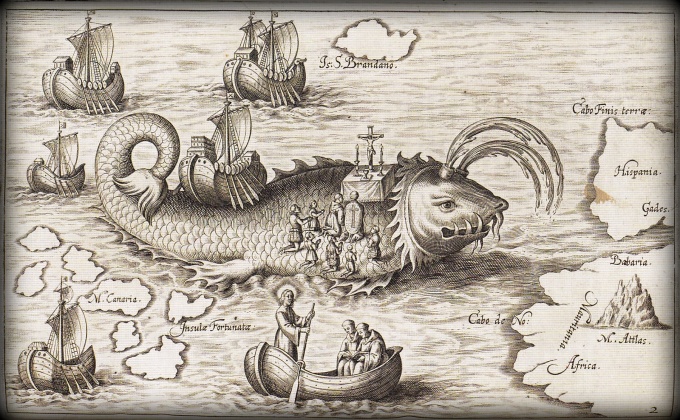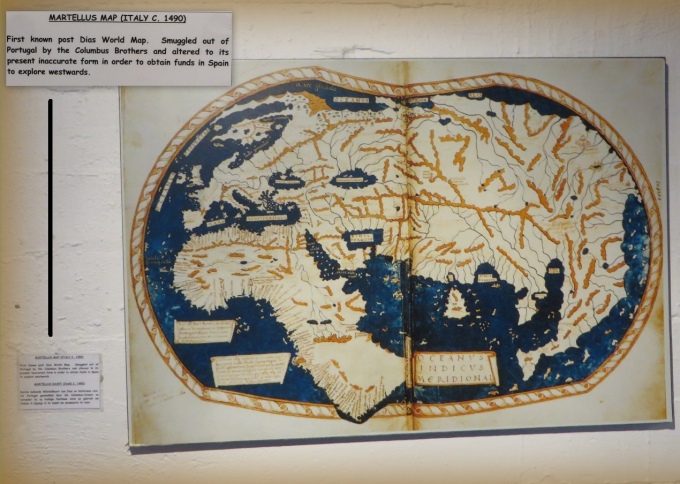Day 15
Miles to go: 1,520
Two weeks at sea, a little more than half way to French Guiana and we're still hovering about 70nm south of the Equator. The moon has waxed to a yellow three-quarter grapefruit and its glow far outshines the stars. The night was lovely, punctuated by a few sprinkles and a quick downpour or two, which we've recently come to expect.
We have seen precious little marine life other than flying fish. We had a wonderful dolphin send- off when we left St. Helena, as you'll remember, but that's been about it. Birds have been in limited quantity as well, though we see a few every day. There's a greater shearwater (or perhaps several, but they all look alike) that likes to land just off our stern and do his fishing in our wake. A tiny, energetic petrel (I think it's a Wilson's storm petrel; David disagrees), a little larger than a robin, skirts within inches of the ocean's surface, dipping, darting and momentarily hovering and tires us out just watching his acrobatic feats.
Then there are red-footed boobies that soar over and around the boat in big swoops and squawk as they pass. They're large birds, like geese, and good divers. They tuck their feet and wings in tightly against their bodies and look like bullets as they plunge at breakneck speeds into the sea. We watched one yesterday that was quite successful catching several fish for breakfast.
On the other hand, despite the success of the birds, we have not fished at all. We used to fish regularly, but haven't bothered to toss a line out since the Indian Ocean. The thought of the blood and gore on the deck isn't pleasant and the requisite clean-up is always a hassle. Besides, we've got plenty of food aboard. I know it sounds mamby-pamby, but after watching the life color seep out of the last dorado we caught, we have no heart for fishing. Yes, we enjoy eating fish and know how they're caught and killed. Still, killing them at our own hand seems different. Not necessarily logical, just how it is. Maybe that will change at some point.
One flying fish in the scuppers this morning. Our passage total is 12, a far cry from our all-time record of 20+ in one night.
Day 16
Miles to go: 1,374
Milestone: Crossing the Line
Despite the fact we've done it before, crossing the Equator is still a momentous occasion and Neptune, of course, required his due as we entered the North Atlantic Ocean and the northern hemisphere. It was my off-watch and I was napping, but David dutifully woke me and I grabbed the camera to capture the moment digitally. We tend to cross the Equator after dark for some reason, which is a shame since you can't see the shimmering yellow demarcation line very well in the dark. Only once have we crossed in the daylight hours. We've never figured out how the line stays in place nor who is responsible for its upkeep.
I need to buy myself one of those sun hats with flaps that fold down covering neck and ears. They're not very stylish, but they're certainly practical. The morning and late afternoon sun rays miss the bimini and beat down relentlessly, frying us in the cockpit. I've taken to wearing a towel or a long-sleeved shirt over my head. I tie the shirt sleeves or towel ends under my chin...anything that extends down long enough to cover my neck, ears and the side of my face. Talk about a fashion statement.
We're just a couple hundred miles north of the Brazilian islands of Fernando de Naronha. We'd talked about stopping there, but were discouraged by the costs involved. We were in touch with three boats that had stopped within the past year and all concurred on the expenses...~$100/day in anchoring and port fees plus a daily parks fee. Additionally, Americans need a Brazilian visa in advance at $160/pp. A day's stay is around $500, a week's stay totaled over $1000...a bit too rich for our budget.
The day was gorgeous...blue skies, big puffy clouds, warm temps, fine breezes...the stuff sailing dreams are made of.
'Crossing the Line Lasagne' was our celebratory dinner.
Two flying fish in the scuppers today...14 total.
Day 17
Miles to go: 1,214
Hard for us to believe, but we've got better winds right here at the Equator than we've had for quite awhile and the forecast looks like they'll continue for a few days. It was a boisterous night punctuated with the usual sprinkles and the day continued in suit with brisk winds and clear sunny skies alternating with sneaky cloudbursts. Typically, we'd be in the doldrums now, doing 50 mile days. Instead we're zipping along at 7 knots in the right direction and chocking up some of our best mileage days thus far on the passage. We're thinking those tots of rum to Neptune are paying off.
Life aboard is good and never boring. We'd hoped to make a sizable dent in the new website update, but publishing issues just before we left were not ironed out, making us leery of progressing too far until we get them sorted out. Sigh! My French review is probably as good as it's going to get. I keep trying to pick up a few new words each day, but until I have to use them in an actual conversation, who knows if I'll actually remember them. I won't be having any philosophical discussions with anyone, but I think we'll be able to order our croissants and cafes au lait okay.
As we get closer and closer to French Guiana, I've been reading my Lonely Planet South America like a novel. The section on the Guianas is short, but quite informative, though nearly 15 years old.
![]() We don't drink when we sail. We know lots of sailors who do. Many indulge in a glass of wine or a beer around dinner time … the proverbial sundowner. Perhaps some might overindulge. We prefer to sail dry for many reasons.
We don't drink when we sail. We know lots of sailors who do. Many indulge in a glass of wine or a beer around dinner time … the proverbial sundowner. Perhaps some might overindulge. We prefer to sail dry for many reasons.





